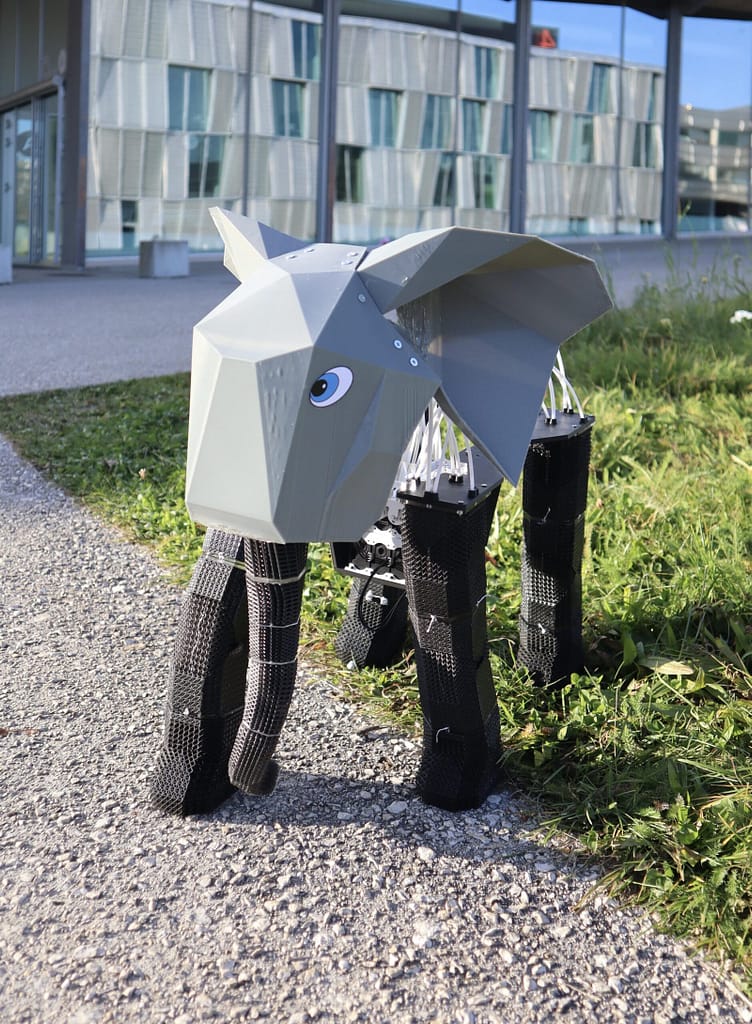A new elephant-inspired robot can do some of the most surprising tasks, from gently plucking a flower with its trunk to powerfully kicking a bowling ball. It’s all thanks to a groundbreaking design approach inspired by the body of an elephant, which combines strong legs and a soft, flexible trunk, and uses only one type of 3D printed material. What makes this robot special is not what it’s made of, but how it’s designed.
The robot was created by Professor Josie Hughes and her team at the CREATE Lab, part of the Institute of Mechanical Engineering at the École Polytechnique Fédérale de Lausanne (EPFL) in Switzerland. The team also included postdoctoral researchers Qinghua Guan and Hung Hon Cheng, as well as PhD student Benhui Dai.
Instead of using different materials for soft and hard parts, the team found a way to shape the inside of a single material using special internal structures, or lattices. By changing the pattern of these lattices, they can make the material act soft in some areas and stiff in others. This lets them build lifelike machines that can move with strength and flexibility, just like real animals.
Lattices are like miniature building blocks or scaffolds inside a material. By changing the shape and pattern of these blocks, the researchers could control how stiff or soft each part of the robot would be. This new design method gives engineers more control over how a robot moves and feels, without needing different materials or complicated manufacturing.
Rewriting Elephant Anatomy
In nature, animals move with the help of muscles, tendons, and bones that all have different stiffness and strength. For example, an elephant’s trunk is soft and flexible, while its legs are strong. The researchers wanted to copy this range of movement and strength in a robot, but without making things too complicated or heavy.
To do this, they invented two main techniques. The first is called Topology Regulation (TR), which lets them gradually blend two different lattice shapes to create parts that transition from soft to stiff. The second is Superposition Programming (SP), a method that stacks or rotates these lattice patterns to control how strong or flexible the material is in specific directions.
Together, these techniques allow the team to design robot parts with custom movement and strength, simply by changing the shape of the material’s internal structure.
The robot elephant they built is a working example of these techniques. It has a long, soft trunk and four strong legs.
The researchers used TR to create a smooth, flexible trunk that can bend, twist, and curl. It is made from lattices that slowly change shape along the trunk’s length. This allows it to grip objects, such as a flower, without crushing them. The trunk is divided into three sections, described as twisting, bending, and helical, that work together using only four motors and a few tendons.
“This approach enables the continuous spatial blending of stiffness profiles and allows for an infinite range of blended unit cells. It’s particularly suited for replicating the structure of muscular organs like an elephant trunk,” says Dai.
Meanwhile, the robot’s legs use SP to create strong joints and bones. These joints can move in one or two directions, allowing the robot to walk, balance, and even kick a bowling ball. Some parts of the legs are stiff and load-bearing, while others are softer and more adaptive, just like real elephant legs.
Each section of the robot is designed to perform a specific motion or task. The feet, for example, are stiffer at the front for support but softer at the back, like the cushioned heels of real elephants, explain the researchers in their study titled “Lattice structure musculoskeletal robots: Harnessing programmable geometric topology and anisotropy,” which was published in Science Advances in July 2025.
In addition to these structural innovations, the team also demonstrated how programmable lattices can support multiple kinds of anatomical movement.
For their elephant model, this dual programming capability enabled the fabrication of several different tissue types with unique ranges of movement, including a sliding plane joint (found in the small bones of the foot), a bending uniaxial joint (found in the knee), and a two-way bending biaxial joint (found in the toes). The team was even able to replicate the complex motion of the elephant’s muscular trunk by engineering separate lattice sections dedicated to twisting, bending, and rotating movements, while maintaining smooth and continuous transitions between them.
Hughes says that in addition to modifying the foam material or incorporating new cell shapes, their unique foam lattice technology structure offers many exciting possibilities for future robotics research.
“Like honeycomb, the strength-to-weight ratio of the lattice can be very high, enabling very lightweight and efficient robots. The open foam structure is well-suited for motion in fluids, and even offers potential for including other materials, like sensors, within the structure to provide further intelligence to foams.”
One Material, Millions of Possibilities
Although only one type of 3D printable material is used to make the robot, the design possibilities are huge. By changing the shape and layout of the internal lattices, the team says they can create over a million different cell types, and possibly more.
Each lattice block can have a different stiffness, depending on its shape or layering. Some are designed to resist bending, while others are designed to twist easily, and some can do both. This gives the robot lifelike movement and precision, while still being lightweight and simple to build.
The entire robot was 3D printed using elastic resin and assembled with tendons and motors to control movement. Because of the open lattice structure, the robot is also lighter, faster to print, and even able to move in water.
According to the study, the researchers were inspired by how evolution has shaped animals for specific movements. Snakes are flexible, cheetahs store energy in their tendons, and human hands are precise. The team believes robots should be built in similar ways, adapted to the jobs they need to do.
Traditional 3D printing uses multiple materials or complicated methods to make robots with different body parts. But these new lattice-based designs allow everything to be made in one printing process, using a single material.
Not Just for Elephants
For future robots, this could translate to faster and cheaper production, and even easier customization. In fact, this new way of building robots could be used in many fields, like healthcare, where custom prosthetic limbs could mimic real muscles and bones. In search and rescue, robots that move like animals could be designed to get through tight or dangerous spaces. And also in manufacturing, lightweight robotic arms could be made to handle delicate or heavy objects. Basically, these lattice structures bring robots one step closer to moving and behaving like living creatures.
The team says their methods can be expanded to even stiffer or softer materials in the future. They also see potential in adding sensors or other intelligent systems inside the lattice foam, creating robots that are not only strong and flexible but also intelligent.
For now, the elephant robot is proof that structure matters just as much as material. By shaping a single substance into millions of forms, engineers have unlocked a new level of control over how robots look, move, and feel. As robotics continues to evolve, this type of “programmable structure” could change the way machines are designed.






